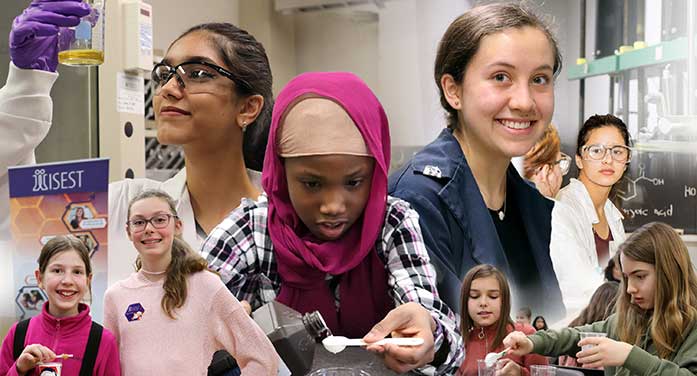While there have been efforts to increase female representation in STEM, the data show there’s still more to be done. The likelihood of a girl enrolled in Grade 1 in Canada going on to receive a PhD in the sciences or engineering is one in 225. When you’re up against those odds, it can be easy to feel like you’ve lost before you’ve even begun.
 Fervone Goings |
 Nancy Manchak |
Elementary school science experiments are fun, but the sense of delight can get lost in later grades.
“If sparking interest were enough, we would have thousands of students applying to be in our post-secondary institutions. We would have gender parity,” said Fervone Goings, team lead for the University of Alberta’s Women in Scholarship, Engineering, Science & Technology (WISEST) program.
WISEST has spent the past 40 years striving to convert a spark of interest into a lasting flame – and it’s working.
The data prove just how effective the program has been. A 2021 study looked at more than 30 years’ worth of statistics tracking the proportion of WISEST summer research program participants who went on to attend the U of A and enrol in STEM disciplines. The average was 84 percent.
Nancy Manchak got involved with WISEST as a 2008 summer research program participant, and she hasn’t really left.
“WISEST is such a part of me,” she said. Manchak was one of that 84 percent who went on to pursue a STEM degree at the U of A, joining the WISEST program committee while studying engineering in her undergraduate years. Now she works as an engineer and serves on the WISEST advisory board.
For Manchak, her experience as a high school student in the summer research program helped shape her career path.
“I discovered what engineering entailed and the potential path my career could take. It took a lot of the uncertainty and the scare factor away from applying for engineering as an undergrad,” Manchak said.
| RELATED CONTENT | |
| Indigenous criminology students seek to change justice system from within By Geoff McMaster |
|
| Internship immerses Black students in STEM, business By Kate Black |
|
| Exuding charisma takes practice By Carol Kinsey Goman |
|
|
Goings explained that WISEST programs make sure students have role models who have been successful in the field.
“A big part of it is that phrase; if you can see it, you can be it,” said Manchak.
“Our goal is to get program participants in front of as many different faces from as many broad backgrounds as possible,” added Goings. “We do a lot of work on the back end to make sure that we are creating these opportunities for introduction.”
From these opportunities, participants often see something that resonates, said Goings. It could be a particular field of study uncovered during a lunchtime conversation with a fellow program participant or even a certain mentor.
While attracting more girls to STEM is a key component of WISEST’s programming, retaining them is more important. Retention is something that Goings knows from personal experience. After obtaining a master’s degree in environmental microbiology and working in STEM for several years, she eventually left to work in other sectors. As she recalls, the barriers faced by women in STEM were a driving force behind that decision.
Now, Goings and the tireless team of WISEST volunteers – numbering more than 235,000 who have given 350,000 hours of their time over the past 40 years – do everything they can to eliminate those barriers for program participants.
“People are giving back to a program that they felt included in, accepted in, supported by,” she said, “and they want to mentor the next generation.”
Goings said self-belief is the missing piece that can turn an early interest in science into a satisfying career. “The student needs to have that moment of transformation where they think, ‘There is a place for me here. I can succeed here.’”
Recent batches of students taking part in WISEST aren’t just looking to boost their resumes with program experience, Goings said. They also want to make the world better.
“There are many challenging problems in the world, and STEM is at the forefront of solving those,” said Manchak.
WISEST lost an outspoken champion in 2019 with the death of founding co-chair Margaret-Ann Armour, whom Goings calls “the driving force behind the program.”
“We’re rooted in this legacy of excellence that was modelled by Dr. Armour. Her commitment to bringing about change is part of our organizational DNA,” said Goings.
“STEM is a place for everyone,” added Manchak. “No matter your background, in STEM there are so many possibilities for the impact you can make.”
| By Adrianna MacPherson
Adrianna is a reporter with the University of Alberta’s Folio online magazine. The University of Alberta is a Troy Media Editorial Content Provider Partner.
The opinions expressed by our columnists and contributors are theirs alone and do not inherently or expressly reflect the views of our publication.
© Troy Media
Troy Media is an editorial content provider to media outlets and its own hosted community news outlets across Canada.


